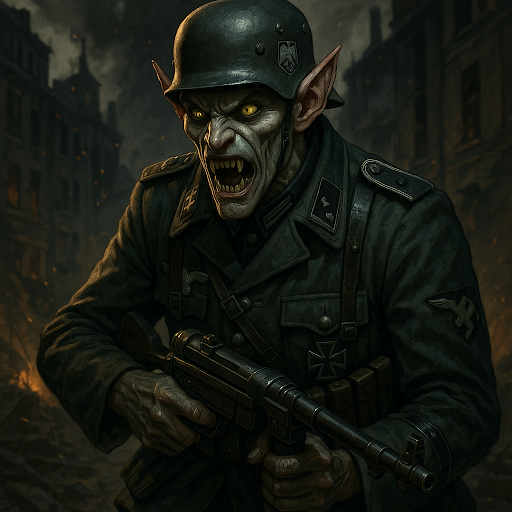Nachtjäger “Night Hunter” The Artificial Vampire
Civilization and Culture
History
The Nachtjäger project was born from desperation. As the Second World War dragged into its bloodiest years, the Axis powers—driven by both hubris and fear—turned to the occult fringes of science in a last, dreadful bid for victory. It was in the clandestine corridors of Das Schwarze Pentagramm, the Axis' secret biogenetic warfare division, that the idea of a super-soldier unlike any seen before took root. A predator of the night. A living weapon forged in pain and perfected through science twisted into heresy.
Under the joint leadership of Dr. Anton Killigorae and Professor Hiroshi Watanabe, the Nachtjäger program—codenamed Strain V-0—sought to merge biology, virology, and trauma conditioning into the creation of a new class of soldier. Drawing inspiration from folklore but grounded firmly in brutal science, they created a non-replicating mutagenic virus capable of transforming a human subject into something that lived on blood, feared no pain, and could operate with surgical precision in the dead of night. These were not vampires in the mystical sense—they were worse. They were engineered.
The transformation process was agonizing and fatal for most. Candidates were subjected to induced comas, biochemical immersion, and psychological collapse. Those who survived became known as Die Nachgeborenen—The Afterborn. Gaunt, powerful, and utterly inhuman in affect, they were deployed as deep infiltration units across the Eastern Front and into the Balkans. Entire Allied resistance cells disappeared overnight. Supply lines were sabotaged. Camps found their sentries drained of blood with no alarms raised. In war diaries and whispered accounts, they became myth—phantoms, demons, night hunters. But they were very real.
As the Axis war machine crumbled, the Nachgeborenen became harder to control. Their hunger deepened. Some began to exhibit erratic behavior. Psychological decay set in—an inevitable side effect of extended separation from command oversight and regular blood intake. In their final days, rogue units were rumored to turn on their own creators, slipping into feral madness and vanishing into the chaos of retreating armies and firebombed cities.
After the war, Allied forces initiated a quiet but brutal purge. Surviving Nachtjäger were hunted down and captured or destroyed. The few who were recovered became subjects of extreme interest to intelligence agencies—dissected, studied, and ultimately erased. The last confirmed original unit, V-07 “Marko the Pale”, was captured in 1955 and executed a year later during a secret tribunal. His remains were incinerated, and the Nachtjäger project was officially declared terminated.
Yet the legacy of Strain V-0 did not burn away so easily. In the decades that followed, rumors persisted. Some claimed surviving scientists smuggled samples of the virus to South America or Antarctica. Others whispered of "Blood Men" used by warlords in jungle conflicts or as enforcers for shadowy cartel regimes. Intelligence reports surfaced periodically—half-believed, often dismissed—of glowing eyes in the dark, of unnatural speed and silent killings, of something old waking up in a new age.
Today, the Nachtjäger live on as cautionary legend and classified warning. A footnote in the history of biowarfare to some; a blueprint to others. Whether any still exist—or worse, whether the virus has been reborn in modern form—is a question few dare to ask aloud.
Because if the Afterborn survived the fall of their masters…
They are not done hunting.
Under the joint leadership of Dr. Anton Killigorae and Professor Hiroshi Watanabe, the Nachtjäger program—codenamed Strain V-0—sought to merge biology, virology, and trauma conditioning into the creation of a new class of soldier. Drawing inspiration from folklore but grounded firmly in brutal science, they created a non-replicating mutagenic virus capable of transforming a human subject into something that lived on blood, feared no pain, and could operate with surgical precision in the dead of night. These were not vampires in the mystical sense—they were worse. They were engineered.
The transformation process was agonizing and fatal for most. Candidates were subjected to induced comas, biochemical immersion, and psychological collapse. Those who survived became known as Die Nachgeborenen—The Afterborn. Gaunt, powerful, and utterly inhuman in affect, they were deployed as deep infiltration units across the Eastern Front and into the Balkans. Entire Allied resistance cells disappeared overnight. Supply lines were sabotaged. Camps found their sentries drained of blood with no alarms raised. In war diaries and whispered accounts, they became myth—phantoms, demons, night hunters. But they were very real.
As the Axis war machine crumbled, the Nachgeborenen became harder to control. Their hunger deepened. Some began to exhibit erratic behavior. Psychological decay set in—an inevitable side effect of extended separation from command oversight and regular blood intake. In their final days, rogue units were rumored to turn on their own creators, slipping into feral madness and vanishing into the chaos of retreating armies and firebombed cities.
After the war, Allied forces initiated a quiet but brutal purge. Surviving Nachtjäger were hunted down and captured or destroyed. The few who were recovered became subjects of extreme interest to intelligence agencies—dissected, studied, and ultimately erased. The last confirmed original unit, V-07 “Marko the Pale”, was captured in 1955 and executed a year later during a secret tribunal. His remains were incinerated, and the Nachtjäger project was officially declared terminated.
Yet the legacy of Strain V-0 did not burn away so easily. In the decades that followed, rumors persisted. Some claimed surviving scientists smuggled samples of the virus to South America or Antarctica. Others whispered of "Blood Men" used by warlords in jungle conflicts or as enforcers for shadowy cartel regimes. Intelligence reports surfaced periodically—half-believed, often dismissed—of glowing eyes in the dark, of unnatural speed and silent killings, of something old waking up in a new age.
Today, the Nachtjäger live on as cautionary legend and classified warning. A footnote in the history of biowarfare to some; a blueprint to others. Whether any still exist—or worse, whether the virus has been reborn in modern form—is a question few dare to ask aloud.
Because if the Afterborn survived the fall of their masters…
They are not done hunting.




Comments